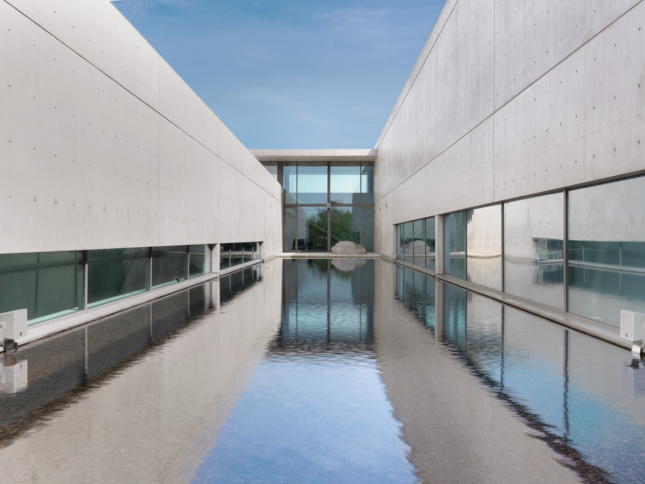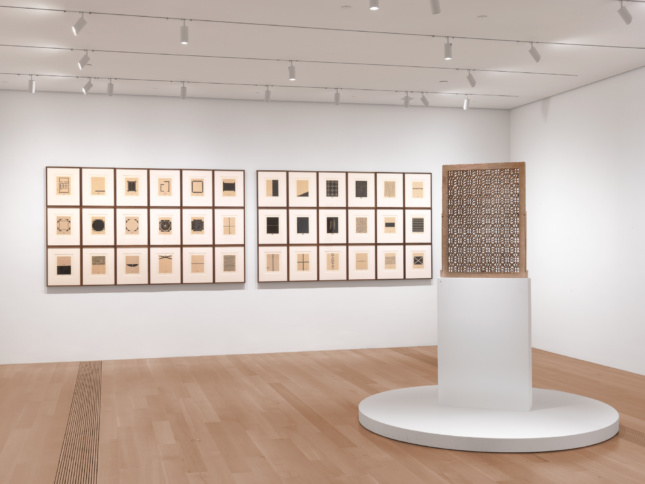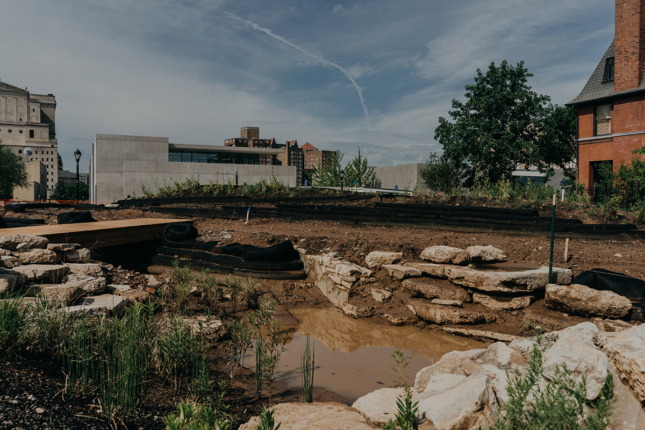St. Louis, Missouri, is having a cultural moment. Architecture-related arts projects abound, meaning artists are taking serious note of how structure and spaces might inspire their work.
In the Pulitzer Arts Foundation’s Tadao Ando-designed building, Turner Prize-winning Scottish artist Susan Philipsz has responded to the building itself. Commissioned for the Foundation’s water court, Too Much I Once Lamented, 2019 features five speakers playing the artist’s sung rendition of a 1622 ballad by composter Thomas Tomkins. It’s a response to the acoustics found in the space’s hard and liquid surfaces. Philipsz, who specializes in sound installations that transform space into “immersive environments of architecture and song,” utilized reflection and projection for this site-specific work.

Also on display at the Foundation is Zarina: Atlas of Her World, created by the Indian-American artist Zarina who wanted to be an architect but instead studied mathematics and printmaking. Now 82-years old, she draws inspiration from her childhood during and after Partition, the 1947 division of British India into the independent states of India and Pakistan. The idea of displacement and the notion of home, together with her interest in modernism, abstraction, and geometry, can be seen in Home Is a Foreign Place (1999). In this piece, Zarina features 36 woodcuts that each evoke architectural spaces (Threshold, Door, and Courtyard).
A grid of arches in Zarina’s Shadow House I, 2008 recalls domestic spaces and jalis, the ubiquitous Indian architectural stone screens. Pool II, 1980, a paper sculpture, “hints at the architecture of her homeland, including courtyards, arches, and stepwells.” Delhi, 2000 is a three-part work showing the city in plan and section.

Across the street from the Ando building on an empty lot, the Foundation has commissioned Park-Like by landscaper designer Chris Carl of Studio Land Arts. Coming next spring, the lot will turn into a sustainable rain garden, plant installation, and public space—a piece of infrastructure for biodiversity. The site was bulldozed to create two hills and during excavation, building fragments were unearthed and incorporated into the design. When it opens, thick black mulch necklaces will snake across the paths as native and non-native plants and flowers carpet spaces for walking, seating, and playing.

Studio Land Arts, a Granite City, Illinois-based firm, sits just across the Mississippi River from St. Louis. It’s a steel-manufacturing town founded in 1896 that’s had a mini-revival in the last decade, though it still suffers from poverty. Newfound enthusiasm in the area has made Granite City a ripe location for creative placemaking.
Groups like Granite City Art and Design District (G-CADD), founded by a trained urban planner who helps microfinance creative spaces, are doing big things. G-CADD’s current New American Gardening project turns vacant lots and post-industrial land into art pieces like Slot Lot, a sculptural reassembly of a parking lot with excavated rectangles reassembled in asphalt stacks. Similar to Park-Like, Slot Lot‘s success is predicated upon the transformation of mundane, everyday spaces that, when paid attention to, become community cornerstones.











